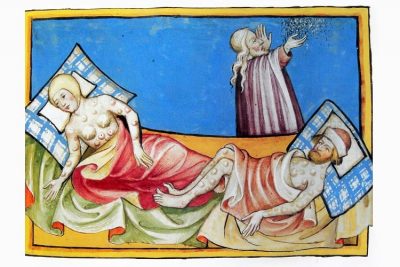Sleep Paralysis: A Reality Check on the Sleep Induced Immobility
Share

Artwork of sleep paralysis. (Henry Fuseli / Wikipedia Commons)
When you lie down to sleep on a bed, it’s never an instant switch off. You loll in bed, change sides and wait for the sleep to overtake you. Similarly, you rise from sleep in snatches of wakefulness, and not an instant switch on. But suppose you wake up from sleep and the first thing you notice is that you can’t move your body; you would indeed be terrified. This condition is called sleep paralysis.
The condition was first recognized as caused by the devil
The disorder can be traced back to 2000 BC, and was then recorded as a ‘bad dream’. People from the Mesopotamian to the Roman Empire believed that bad dream was caused by the demon incubus. In Latin, incubus means ‘to-sit-on’. The demon sat on the chest of its victim, gave them terrifying dreams. The hangover of these dreams persisted well into wakefulness, making them unable to get up in first few attempts after waking up.
Subsequently called nightmare
By the late 19th century, this condition came to be known as ‘nightmare’. Temporary immobilisation of body either at the point of sleeping, or waking up. The word ‘mare’ in Old Norse (North Germanic language) means ‘crusher’ and stands for the crushing weight of the demon or ghost who rides on the chest of his victims.
The syndrome is seen more often in people suffering from narcolepsy (excessive sleepiness) and post-traumatic stress disorder (PTSD). It has also been observed in cases of prolonged insomnia, errors of medical anaesthesia, and high-stress levels. As the condition is unpredictable, it leaves a person frightened and shaken to bones.
It is a disconnect of the brain from the body
Except for its fearful and stinging memory, the sleep paralysis is not a malignant condition. In simple words, it is a lack of rapport between the brain and the rest of the body. As one retires to sleep at the end of the day, the nervous system, as well as the muscular system, must lie low to make way for sleep. Brain, accordingly, directs the nervous system to relax muscles and make them inactive. That’s important because the brain continues to function during the sleep and muscles may become active in sync with brain activity. Like, one may not actually get up and start walking if he is dreaming a walk. Incidentally, though, cases of dream-walkers are on record and that too is a condition where the brain and the body are acting at cross purposes. Normally, before deep sleep, the brain takes care to relax the body muscles. Equally, when a man is done with sleep, the brain allows muscles to activate and get going. But somewhere, either the brain miss-commands or the muscles don’t-obey, resulting in sleep paralysis.
Symptoms of sleep paralysis
Three symptoms are indicative of sleep paralysis. One, inability to move or speak on regaining consciousness from a good or bad sleep. Two, a strong feeling that there is some person or thing close to the bed. Three, a choking pressure on the chest. Anyone of these symptoms, or their combinations, are indicative of this condition which is also called parasomnia.
Can’t move muscles
As for the inability to move, it is an indication that the brain and muscles are not on the same page, as they are supposed to be. While going to sleep, muscles relax following the brain command to lie low. On completion of sleep, either the brain missed commanding muscles to activate, or the muscles failed to follow the brain’s order for activation.
The hallucination of something near
Presence of strange person or thing near the bed points to the momentum of bad dream the person had during his sleep time. This points to brain malfunction; inability to comprehend the reality of wakefulness from an illusion of dream sequence.
Unbearable weight on the chest
Pressure on the chest may both be psychological, the fear stemming out of a bad dream, or somatic, i.e. a consequence of ailment or disease the man may be suffering from.
A night terror is different
Sleep paralysis needs to be separated from ‘Night Terror’ which happens when the person is still in deep sleep. Herein, a terrifying dream may so overwhelm a person that he wakes up and tries to save self without realising his whereabouts. This again is a brain-body jam, but of a different kind. Not sleep paralysis.
Sleep is a second stage process
Technically speaking, sleep has two major parts. One, the stage of Non-Rapid Eye Movement (NREM), this is also called quiet sleep. Two, the stage of Rapid Eye Movement (REM), also called the ‘active sleep’ or the ‘paradoxical sleep’. The act of sleeping begins with lying down on the bed, while still conscious of our thoughts and body movements. Then begins the 1st stage of NREM.
Non-Rapid Eye Movement (NREM) stage
The 1st stage of NREM is the window from wakefulness to sleep. Herein, if a person is shaken by someone to get up, he would get up and say he wasn’t sleeping. Then comes the 2nd stage of NREM. Lasting about 20 minutes, this stage is characterized by a fall in awareness of the surroundings and a drop in body temperature. The respiration and the heartbeat get stabilized. In the 3rd stages of NREM, muscles relax, blood pressure comes down, breathing is slow and steady, and the man slips into a deep sleep.
The NREM (Non-Rapid Eye Movement) is a complicated stage in itself as proved by an abnormality called sexsomnia. A person suffering from this condition, if sleeping next to another person, may engage in penetrative sex without being aware of it. Surprisingly, in many cases of such sexual abuse, the accused was let go by the law on the premise that he suffered from sexsomnia and that he was not consciously aware of the abuse that he committed.
Rapid Eye Movement (REM) Stage
The 3rd stage of NREM is followed by REM stage. The REM stage is characterized by the eyes (eyeballs) moving swiftly in their sockets, the body becoming more relaxed and immobilized, peak-dreaming, and brain going in hyper mode. It is also called paradoxical sleep as it has a hyperactive brain presiding over relaxed and inactive body muscles.
Sleep soothes body systems
It goes without saying that sleep is crucially important for health. Importance of sleep hardly needs elucidation. It is a phase of suspended animation in which the brain ensures repair work of the wear and tear in body tissues. But more important than this is the processing of complex thoughts. Hopes, aspirations, fears, setbacks of the individual need sorting so that the person gets up refreshed, physically and mentally. Otherwise, the negative thoughts can harm the person and endanger life.
Sleep balances the conscious and the subconscious mind
It is pertinent to note, that the working of the conscious mind during wakefulness, is just a minuscule of the sum total of our brain activity. A much bigger and potent thought process goes on, insidiously, below this layer of conscious mind. It is called the subconscious mind. Sleep is a bridge between these two minds. Going to sleep literally means slipping into the zone of the subconscious. In a dream one can fly, meet ghosts, do and see impossible; is all thanks to the subconscious mind. Dreams, in a way, are cathartic and act as an outlet for unrealistic and harmful thoughts. Hyperactivity of the brain in the REM phase is actually for striking a healthy balance between these two minds: the conscious and the subconscious.
Lifestyle matters
Imagine a man suffering from some acute or chronic disease. A man taking late nights cups of tea, or intoxicants. In such case sleep would be affected. Brain would face additional task of sorting out man’s complicated emotional inputs. The wrongs of lifestyle may pile up more pressure on the brain than it can handle. This weakens mind-body integrity which may lead to various disorders. Add to this the highly complex nature of sleep itself, and one can understand why sleep paralysis is such an enigma.
No specific treatment for it
Obviously, sleep paralysis is a state of being, and not a disease. Statistically, about 50% of the people suffer from this condition at some stage of their life. Individuals suffering from other physical and mental disorders are more likely to have brush with sleep paralysis. Essentially, it is an overlap of REM sleep with wakefulness. Man does get control of his muscles to post waking up, but after some time gap, not immediately. There is no specific treatment for it. In the past people were treated by bleeding, rubbing of the extremities, and drastic purgatives. Even prayers and exorcism was tried. An 18th-century prescription was to give pinprick or a rude shake to the person. Modern medical treatment is also empirical but care is taken to go to the root of the psychosomatic problems responsible for sleep paralysis.
Enjoyed this article? Also, check out “Under the Sea: Do Fishes Dream?“.
Fact Analysis:
STSTW Media strives to deliver accurate information through careful research. However, things can go wrong. If you find the above article inaccurate or biased, please let us know at [email protected]













